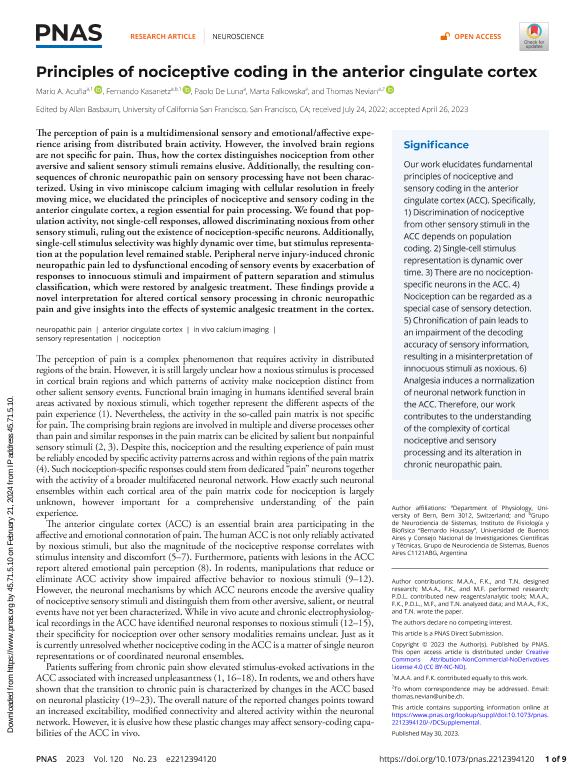Mostrar el registro sencillo del ítem
dc.contributor.author
Acuña, Mario A.
dc.contributor.author
Kasanetz, Fernando

dc.contributor.author
De Luna, Paolo
dc.contributor.author
Falkowska, Marta
dc.contributor.author
Nevian, Thomas

dc.date.available
2024-02-21T15:45:09Z
dc.date.issued
2023-06
dc.identifier.citation
Acuña, Mario A.; Kasanetz, Fernando; De Luna, Paolo; Falkowska, Marta; Nevian, Thomas; Principles of nociceptive coding in the anterior cingulate cortex; National Academy of Sciences; Proceedings of the National Academy of Sciences of The United States of America; 120; 23; 6-2023; 1-9
dc.identifier.issn
0027-8424
dc.identifier.uri
http://hdl.handle.net/11336/227888
dc.description.abstract
The perception of pain is a multidimensional sensory and emotional/affective experience arising from distributed brain activity. However, the involved brain regions are not specific for pain. Thus, how the cortex distinguishes nociception from other aversive and salient sensory stimuli remains elusive. Additionally, the resulting consequences of chronic neuropathic pain on sensory processing have not been characterized. Using in vivo miniscope calcium imaging with cellular resolution in freely moving mice, we elucidated the principles of nociceptive and sensory coding in the anterior cingulate cortex, a region essential for pain processing. We found that population activity, not single-cell responses, allowed discriminating noxious from other sensory stimuli, ruling out the existence of nociception-specific neurons. Additionally, single-cell stimulus selectivity was highly dynamic over time, but stimulus representation at the population level remained stable. Peripheral nerve injury-induced chronic neuropathic pain led to dysfunctional encoding of sensory events by exacerbation of responses to innocuous stimuli and impairment of pattern separation and stimulus classification, which were restored by analgesic treatment. These findings provide a novel interpretation for altered cortical sensory processing in chronic neuropathic pain and give insights into the effects of systemic analgesic treatment in the cortex.
dc.format
application/pdf
dc.language.iso
eng
dc.publisher
National Academy of Sciences

dc.rights
info:eu-repo/semantics/openAccess
dc.rights.uri
https://creativecommons.org/licenses/by-nc-nd/2.5/ar/
dc.subject
ANTERIOR CINGULATE CORTEX
dc.subject
IN VIVO CALCIUM IMAGING
dc.subject
NEUROPATHIC PAIN
dc.subject
NOCICEPTION
dc.subject
SENSORY REPRESENTATION
dc.subject.classification
Neurociencias

dc.subject.classification
Medicina Básica

dc.subject.classification
CIENCIAS MÉDICAS Y DE LA SALUD

dc.title
Principles of nociceptive coding in the anterior cingulate cortex
dc.type
info:eu-repo/semantics/article
dc.type
info:ar-repo/semantics/artículo
dc.type
info:eu-repo/semantics/publishedVersion
dc.date.updated
2024-02-20T12:51:42Z
dc.journal.volume
120
dc.journal.number
23
dc.journal.pagination
1-9
dc.journal.pais
Estados Unidos

dc.journal.ciudad
Washington D. C.
dc.description.fil
Fil: Acuña, Mario A.. University of Bern; Suiza
dc.description.fil
Fil: Kasanetz, Fernando. Consejo Nacional de Investigaciones Científicas y Técnicas. Oficina de Coordinación Administrativa Houssay. Instituto de Fisiología y Biofísica Bernardo Houssay. Universidad de Buenos Aires. Facultad de Medicina. Instituto de Fisiología y Biofísica Bernardo Houssay; Argentina. University of Bern; Suiza
dc.description.fil
Fil: De Luna, Paolo. University of Bern; Suiza
dc.description.fil
Fil: Falkowska, Marta. University of Bern; Suiza
dc.description.fil
Fil: Nevian, Thomas. University of Bern; Suiza
dc.journal.title
Proceedings of the National Academy of Sciences of The United States of America

dc.relation.alternativeid
info:eu-repo/semantics/altIdentifier/url/https://www.pnas.org/doi/10.1073/pnas.2212394120
dc.relation.alternativeid
info:eu-repo/semantics/altIdentifier/doi/https://doi.org/10.1073/pnas.2212394120
Archivos asociados
